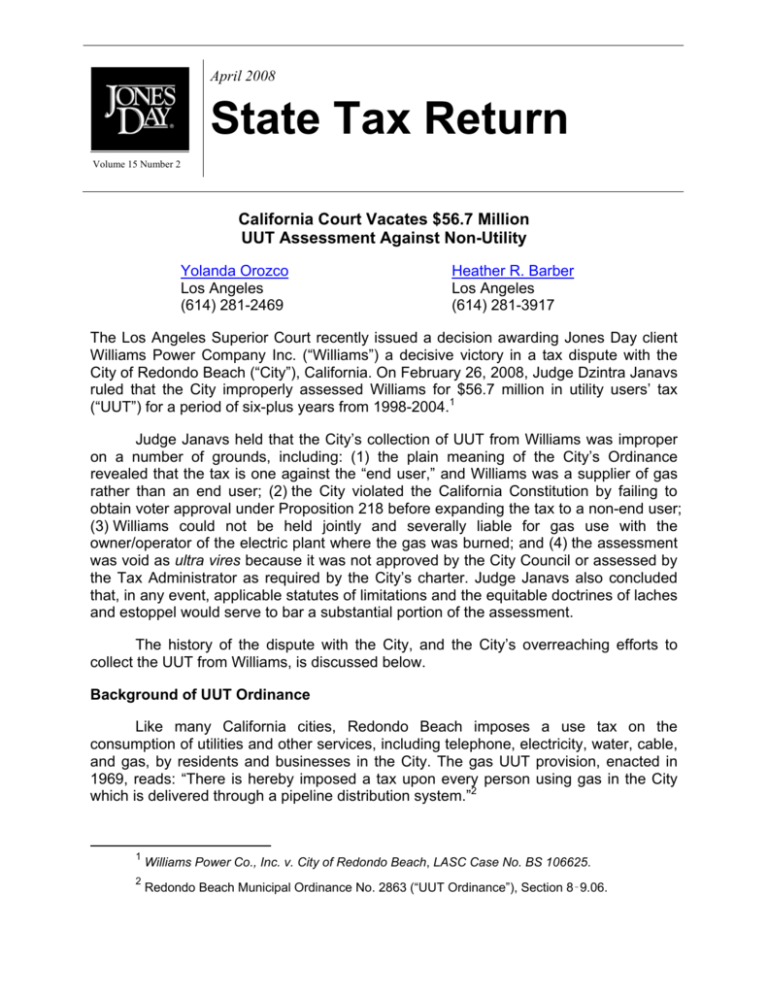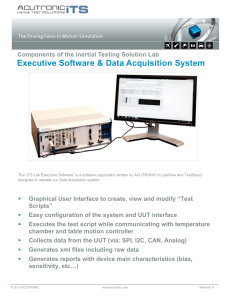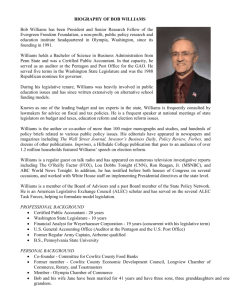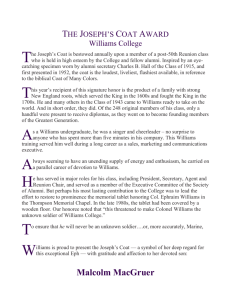
April 2008
State Tax Return
Volume 15 Number 2
California Court Vacates $56.7 Million
UUT Assessment Against Non-Utility
Yolanda Orozco
Los Angeles
(614) 281-2469
Heather R. Barber
Los Angeles
(614) 281-3917
The Los Angeles Superior Court recently issued a decision awarding Jones Day client
Williams Power Company Inc. (“Williams”) a decisive victory in a tax dispute with the
City of Redondo Beach (“City”), California. On February 26, 2008, Judge Dzintra Janavs
ruled that the City improperly assessed Williams for $56.7 million in utility users’ tax
(“UUT”) for a period of six-plus years from 1998-2004.1
Judge Janavs held that the City’s collection of UUT from Williams was improper
on a number of grounds, including: (1) the plain meaning of the City’s Ordinance
revealed that the tax is one against the “end user,” and Williams was a supplier of gas
rather than an end user; (2) the City violated the California Constitution by failing to
obtain voter approval under Proposition 218 before expanding the tax to a non-end user;
(3) Williams could not be held jointly and severally liable for gas use with the
owner/operator of the electric plant where the gas was burned; and (4) the assessment
was void as ultra vires because it was not approved by the City Council or assessed by
the Tax Administrator as required by the City’s charter. Judge Janavs also concluded
that, in any event, applicable statutes of limitations and the equitable doctrines of laches
and estoppel would serve to bar a substantial portion of the assessment.
The history of the dispute with the City, and the City’s overreaching efforts to
collect the UUT from Williams, is discussed below.
Background of UUT Ordinance
Like many California cities, Redondo Beach imposes a use tax on the
consumption of utilities and other services, including telephone, electricity, water, cable,
and gas, by residents and businesses in the City. The gas UUT provision, enacted in
1969, reads: “There is hereby imposed a tax upon every person using gas in the City
which is delivered through a pipeline distribution system.”2
1
2
Williams Power Co., Inc. v. City of Redondo Beach, LASC Case No. BS 106625.
Redondo Beach Municipal Ordinance No. 2863 (“UUT Ordinance”), Section 8‑9.06.
©Jones Day 2008
The City’s Attempt to Impose UUT on AES Redondo Beach, LLC
In 1998, Southern California Edison (“Edison”) sold electric plants located in
Long Beach, Huntington Beach, and Redondo Beach to affiliate companies of AES.
AES owns, operates, controls, and manages all the plants. Williams is involved in
wholesale power and gas marketing. Shortly after AES acquired the plants, AES and
Williams entered into a Capacity Sale and Tolling Agreement that covered the three
power plants and pursuant to which Williams delivered natural gas to the plants. Under
the Tolling Agreement, AES took sole custody of the gas and used it to generate
electricity, while Williams retained title to the gas and to the electricity produced.
During the time that Edison owned the plants, Edison was exempt from UUT
because of a recognized exemption for entities conducting the business of a utility.
When AES acquired Edison’s plants, it sought the same exemption from the three cities.
Long Beach and Huntington Beach granted AES a UUT exemption for gas used
at those facilities. Redondo Beach, on the other hand, threatened AES with imposition
of UUT on gas used in the electrical generating process, asserting that the exemption in
the UUT Ordinance applied only to public utilities, and AES was not one.
Despite this threat, the City recognized that it needed to obtain voter approval
pursuant to Proposition 218 because the exemption, on its face, applied to all utilities -not only “public utilities” regulated by the Public Utilities Commission. Because
California’s Proposition 218 prohibits local governments from imposing, extending, or
increasing any tax unless approved by a majority vote of the electorate, the City’s Tax
Administrator advised the City Council that voter approval was likely required before the
City could assess UUT on AES.
The City Enters Into Negotiations With AES
Rather than seek a ballot initiative to remove the tax exemption, the City entered
into negotiations with AES to resolve the UUT issue and work collaboratively with AES
on the best use of the Plant and its surrounding property. On December 8, 1998, AES
and the City entered into a Memorandum of Understanding (“MOU”), pursuant to which
the City agreed to withdraw the ballot measure to eliminate AES’ UUT exemption. In
return, AES agreed to undertake certain redevelopment work at the Plant site, and both
parties agreed to work toward a master plan for development of the property.
Significantly, during the City Council meetings and the discussions between the City
and AES surrounding the MOU and the exemption issue, Williams was never mentioned
as a party potentially liable for UUT on gas used at the AES Plant.
After the MOU took effect, the City sent letters to gas suppliers and other utilities
instructing them to cease collecting UUT until further notice, a fact Judge Janavs found
compelling in ruling in favor of Williams. Although the MOU initially was for a period of
two years, at the conclusion of the two-year term, the City and AES continued to work
together as if the MOU were still in effect. The City did not (i) retract its exemption
instructions to the utility suppliers to cease UUT collection; (ii) attempt another ballot
©Jones Day 2008
measure under Proposition 218; or (iii) undertake any efforts to collect UUT from AES,
much less from Williams.
December 7, 2004 City Council Meeting
The UUT issue did not surface again until six years later. At a December 7, 2004,
City Council meeting, the Tax Administrator again raised the issue of AES’s liability for
UUT and the applicability of the exemption. The Tax Administrator again recommended
that a ballot measure be placed before the voters so that the voters could decide
whether to eliminate the UUT exemption for AES. After a midnight closed session, the
City Council announced that no voter approval was required before imposing UUT on
AES, and it instead declared that AES was liable for “past, present and future UUT.”
The City Council directed the City Manager to issue a tax assessment to AES. Notably,
the City Council’s directive was silent as to issuance of an assessment to Williams,
another fact that weighed heavily in Williams’ favor.
The City Manager Sends A Bill to AES and Williams
On January 26, 2005, the City Manager sent a $72 million assessment for back
UUT, interest and penalties to both AES and Williams, for gas use at the AES Plant
from May 1998 to September 2004. Several months later, the City’s auditor confessed
to several “calculation errors” and corrected the assessment to $56,717,850.44.
Penalties and interest comprised approximately $20 million of that sum.
Williams and AES objected to the assessment and, in accordance with the
provisions of the UUT Ordinance, requested a hearing before the City’s Tax
Administrator. After a four-day hearing marred by due process violations and one-sided
evidentiary ruling favoring the City, the Tax Administrator issued a written decision
finding AES and Williams jointly and severally liable for the entire $56.7 million in backUUT.
Under the UUT Ordinance, AES and Williams were entitled to appeal the Tax
Administrator’s decision to a hearing officer selected by the City. The City’s hand-picked
hearing officer issued his decision on December 13, 2006, finding that AES was a
“utility,” which is exempt from UUT. Although the hearing officer acknowledged that
Williams did not burn gas at the Plant, he nevertheless concluded that Williams “used”
gas by exercising ownership and control of the gas during the electrical conversion
process. The hearing officer reached this conclusion by borrowing a broad definition of
“use” from the “sales and use” tax statute in the Revenue & Taxation code, ignoring
commentary from the California Supreme Court that “sales and use” taxes are
substantially different from UUT.3 Accordingly, the hearing officer found that Williams
alone was liable for the entire $56.7 million assessment.
3
Rivera v. City of Fresno, 6 Cal. 3d 132, 137 (1971), disapproved on different grounds in
Yamaha v. State Bd. of Equalization, 19 Cal. 4th 1 (1998).
©Jones Day 2008
Proceedings Before Judge Janavs
In December 2006, Williams filed a petition for writ of administrative mandamus
in the California Superior Court challenging the hearing officer’s decision on multiple
grounds, without paying the disputed tax. The City demurred to Williams’ petition,
asserting that Williams was required to pay the entire $56.7 million assessment before it
could litigate its petition under the so-called “pay first, litigate later” doctrine embodied in
Article XIII, Section 32 of the California Constitution. Although Williams argued that the
“pay first” doctrine did not apply to local assessments, the Court held otherwise and
required that Williams pay the full assessment in order to prosecute its writ. Williams did
so.
On Valentine’s Day, February 14, 2008, Williams argued its request for issuance
of a writ of mandate to the Court, pointing out that the assessment was improper on
multiple grounds. First, Williams argued that it does not “use” gas within the plain
meaning of the UUT Ordinance. The plain language of the UUT Ordinance confirms that
the UUT is an end-user consumption tax on the use of utilities, and because Williams
simply supplies the gas that AES burns, Williams is not subject to UUT. Second,
Williams argued that the hearing officer’s attempt to borrow a broad definition of “use”
from the Revenue & Taxation Code was erroneous. Third, Williams argued that the
hearing officer’s implicit finding of joint and several liability with AES was erroneous.
Because the UUT Ordinance did not explicitly provide for joint and several liability, and
because it was undisputed AES alone used the gas by burning it to generate electricity,
Williams contended that the assessment against Williams was improper. Fourth,
Williams argued that the City violated Proposition 218 by imposing UUT on Williams
without voter approval. Under a recent California Court of Appeal case interpreting
Proposition 218, the Court held that a local government’s introduction of a “new
variable” in the manner of assessing the tax constituted a change in methodology
requiring voter approval. AB Cellular LA, LLC v. City of Los Angeles.4 Because the City
had never before assessed UUT against a “supplier” rather than an end-use consumer,
Williams argued the City’s change in methodology required voter approval. Fifth,
because the City Manager, rather than the Tax Administrator, issued the January 2005
assessment, and the City Council never voted to assess UUT as to Williams, Williams
argued the assessment was void as ultra vires. Finally, Williams argued in the
alternative that over 80% of the assessment was barred by the applicable statutes of
limitation and the equitable doctrines of laches and estoppel.
The Court agreed with each of Williams’ points, and vacated the hearing officer’s
decision in its entirety. In a detailed Statement of Decision issued on February 26, 2008,
Judge Janavs found that, as a matter of law, Williams was not liable for any UUT for the
reasons described above. Williams is likely to obtain a full refund of the $56.7 million it
was required to “pay first,” plus interest at a rate of 7% per annum from the date the
sum was tendered.■
4
AB Cellular LA, LLC v. City of Los Angeles, 150 Cal. App. 4th 747 (2007).
©Jones Day 2008
This article is reprinted from the State Tax Return, a Jones Day monthly newsletter reporting on
recent developments in state and local tax. Requests for a subscription to the State Tax Return or
permission to reproduce this publication, in whole or in part, or comments and suggestions should be
sent to Teresa M. Barrett-Tipton (214.969.5186) in Jones Day’s Dallas Office, 2727 N. Harwood,
Dallas, Texas 75201 or StateTaxReturn@jonesday.com.
©Jones Day 2008. All Rights Reserved. No portion of the article may be reproduced or used without express
permission. Because of its generality, the information contained herein should not be construed as legal advice on
any specific facts and circumstances. The contents are intended for general information purposes only.









